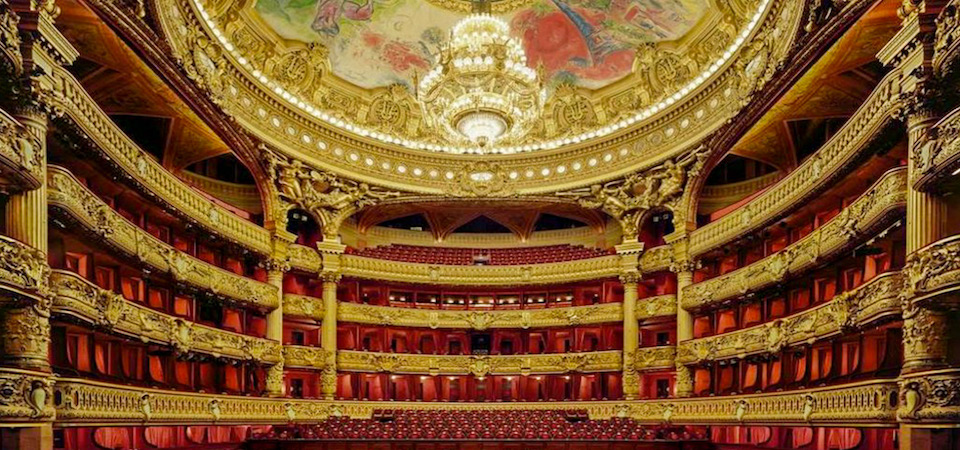- 23 août 2017
- La scène parisienne
- Kate Cusick
Blog mis à jour le 25 juillet 2025.
Les théâtres secrets incontournables à Paris
Lors d’un séjour à Paris, de nombreux voyageurs choisissent, bien sûr, de visiter les monuments emblématiques : la tour Eiffel, le Louvre, l’Opéra Garnier ou encore l’Arc de Triomphe. Pourtant, au-delà de ces merveilles, la ville offre une scène théâtrale unique, vivante et profondément ancrée dans la vie quotidienne des Parisiens.
L’un des secrets les mieux gardés de Paris réside dans ses théâtres historiques, hérités de l’époque des rois ou fondés durant les effervescentes Années folles. Ces lieux, souvent méconnus des visiteurs, témoignent de la richesse culturelle et artistique de la capitale française.
Theatre in Paris vous invite à sortir des sentiers battus et à découvrir la magie des théâtres cachés, véritables joyaux architecturaux et témoins de siècles de création artistique.
Et oui, Paris propose de plus en plus de spectacles surtitrés. Une aubaine pour les amoureux de spectacles !

1. Théâtre Le Ranelagh
Machine à remonter le temps et/ou théâtre ? Pourquoi pas les deux ! Le Théâtre Le Ranelagh propose des pièces du répertoire classique comme L’Avare de Molière et Cyrano de Bergerac.
Autrefois situé en dehors des limites de Paris, ce théâtre fut édifié au sein du Château de Boulainvilliers, propriété d’Alexandre Le Riche de La Pouplinière, l’un des plus grands mécènes des arts du XVIIIe siècle. Ce lieu culturel exceptionnel attirait des esprits brillants tels que Voltaire, Rameau ou encore Diderot, réunis dans une atmosphère de création, de débat et d’élégance.
Dévastée par la Révolution, la demeure fut rachetée à la fin du XIXe siècle par Louis Mors, industriel visionnaire et mélomane passionné. En 1894, il fit reconstruire le théâtre exactement à l’emplacement de l’ancienne salle de musique de La Pouplinière, lui redonnant vie avec faste et raffinement.
Aujourd’hui, les somptueuses boiseries sculptées en chêne, dans un style néo-Renaissance, enveloppent le spectateur d’une chaleur visuelle et sonore unique, offrant une acoustique d’une rare qualité. Véritable écrin, le Théâtre Le Ranelagh présente désormais les plus grands classiques du répertoire dans des mises en scène modernes et vibrantes qui plaisent aux petits comme aux grands.

2. La Comédie-Française – Salle Richelieu
L’un des plus anciens théâtres encore en activité au monde, la Comédie-Française fut fondée en 1680 par décret royal, symbole éclatant de l’amour de la France pour l’art dramatique. Habillée de velours cramoisi, de franges dorées, de colonnes doriques et d’élégantes structures en fonte, sa majestueuse salle de forme ovale accueillait autrefois l’élite de la noblesse française, venue applaudir les grands classiques dans une ambiance de faste et de raffinement.
Secouée par une violente querelle politique entre comédiens durant la Révolution, la troupe fut dispersée, mais renaquit avec éclat grâce à l’inauguration de la Salle Richelieu en 1799, devenue depuis la scène emblématique de l’institution.
Fidèle à ses racines mais tournée vers l’avenir, la Comédie-Française honore les œuvres de Molière, son fondateur spirituel, et de Racine, tout en explorant aujourd’hui un répertoire riche de plus de 3 000 pièces, mêlant tragédies classiques, créations contemporaines et mises en scène audacieuses. Véritable temple du théâtre français, elle continue de faire vibrer générations après générations par son excellence artistique et son rayonnement international.
Les lunettes connectées à la Comédie-Française
Des lunettes de surtitrage, développées par notre société-sœur Panthea, permettent aux publics anglophones, sourds et malentendants de suivre des pièces de théâtre françaises grâce à des surtitres en anglais ou en langue des signes française (LSF). Ces lunettes connectées sont désormais proposées en salle Richelieu à la Comédie-Française !
Voici quelques pièces qui joueront la saison prochaine (2025-2026) avec ce dispositif : Une mouette d’après Anton Tchekhov, Le Misanthrope de Molière.

3. Le fabuleux Palais Garnier
Pénétrez dans l’un des opéras les plus légendaires au monde, et laissez-vous emporter par l’atmosphère envoûtante du Palais Garnier, véritable écrin de mystère qui inspira le célèbre roman Le Fantôme de l’Opéra, roman français « à la lisière du policier et du fantastique » écrit par Gaston Leroux et publié en 1910.
Le Palais Garnier, chef-d'œuvre architectural, somptueusement décoré de dorures, de velours, de marbre polychrome, de miroirs scintillants et de statues allégoriques, incarne le raffinement absolu du Second Empire.
Fruit d’un concours d’architecture lancé en 1860 et remporté par Charles Garnier, ce bâtiment monumental devint l’un des plus ambitieux et onéreux projets de son siècle. Il s’imposa très vite comme une icône du paysage parisien, aux côtés du Louvre et de Notre-Dame.
Sa salle de spectacle, en fer à cheval selon la tradition italienne, abrite la plus vaste scène d’Europe, surplombée d’un plafond féérique peint par Marc Chagall en 1964, et illuminée par un imposant lustre en cristal et laiton de plus de sept tonnes.
Du majestueux Grand Escalier au somptueux Grand Foyer, chaque recoin de l’édifice déborde de détails sculptés, de symboles mythologiques et d’un luxe inouï. Le Palais Garnier n’est pas seulement un opéra : c’est une ode à l’art, à la beauté et à l’imagination.

4. L’impressionnant Théâtre du Châtelet
Érigé en 1860 à l’emplacement d’un ancien châtelet – petite forteresse médiévale gardant l’accès de Paris – le Théâtre du Châtelet fut commandé par le légendaire Baron Haussmann, dans le cadre de sa vaste transformation urbaine de la capitale. Conçu pour impressionner, ce théâtre monumental situé en plein cœur de la ville devint rapidement un haut lieu du spectacle vivant.
C’est entre ses murs que fut créée la célèbre adaptation scénique du roman de Jules Verne, Le Tour du monde en quatre-vingts jours, jouée sans interruption pendant 64 années, totalisant 2 195 représentations. Cette incroyable longévité prit fin en mai 1940, interrompue brutalement par l’occupation allemande de Paris.
Depuis son inauguration, le Théâtre du Châtelet a accueilli une diversité étonnante de spectacles : opérettes fastueuses, grandes revues, ballets classiques, concerts symphoniques, récitals et opéras. Il s’impose aujourd’hui comme un lieu éclectique, où l’innovation artistique se mêle à la tradition.
Aujourd’hui, ce théâtre emblématique poursuit sa mission culturelle avec une programmation résolument moderne et internationale, et accueille des formations prestigieuses comme l’Orchestre de Paris et l’Orchestre Philharmonique de Radio France. Le Châtelet reste plus que jamais un théâtre ouvert sur le monde, fidèle à son esprit d’aventure et de découverte.

5. Le discret Théâtre Edouard VII
Envie de marcher dans les pas d’un roi ou de croiser l’ombre d’Orson Welles ? Poussez les portes du Théâtre Édouard VII, niché sur une petite place discrète et élégante, à deux pas du tumulte des grands boulevards. Ce havre inattendu, presque secret, semble suspendu hors du temps, protégé du rythme effréné de la ville.
Construit au début des années 1900 en hommage à Édouard VII, surnommé « le plus Français des rois britanniques », ce théâtre fut imaginé comme un lieu de dialogue entre Paris et le monde anglo-saxon. Le roi, amateur d’art éclairé et amoureux de la capitale, rêvait d’un espace où les cultures pourraient se rencontrer avec panache.
Derrière sa façade discrète, le théâtre a vu défiler Sacha Guitry, Jean Cocteau et Orson Welles, dont la silhouette légendaire hanterait encore les coulisses. L’élégance de la salle, la richesse de son histoire et son atmosphère feutrée confèrent à ce lieu un charme tout particulier, renforcé par le calme enveloppant de la place qui l’abrite.
Aujourd’hui, le Théâtre Édouard VII perpétue l’esprit vif et raffiné de la comédie parisienne, avec une programmation audacieuse mêlant humour, esprit et modernité. C’est dans ce théâtre que fut crée il y a quelques années la fameuse comédie, Le prénom.
Un joyau caché, à découvrir le temps d’une soirée, comme un secret bien gardé au cœur de Paris.

6. Théâtre de la Gaîté Montparnasse
Au cœur du bouillonnant quartier de Montparnasse, haut lieu de la bohème parisienne, fréquenté par des générations d’artistes, de rêveurs, d’intellectuels et de noctambules, se cache un théâtre au passé aussi riche que vibrant.
L’histoire de ce lieu mythique remonte à 1867, lorsque François Jamin érigea un café-concert animé à partir des matériaux récupérés du Théâtre de l’Exposition. Le public y venait boire, chanter, danser, rire et s’émouvoir dans une atmosphère aussi populaire qu’exaltée — un monde à mille lieues de l’expérience théâtrale classique.
Dans les décennies suivantes, un théâtre plus moderne prit forme, accueillant sur scène un mélange éclectique de sketchs, parodies, chansons engagées et lectures poétiques. Pendant la Seconde Guerre mondiale, il devint un refuge de divertissement, où se produisaient artistes et troupes venus soutenir le moral des civils et des soldats.
Alors qu’il faillit disparaître sous la menace de la démolition, le théâtre fut sauvé in extremis par des amoureux de la scène, convaincus de sa valeur patrimoniale. Grâce à eux, ce lieu unique continue aujourd’hui de faire vibrer Montparnasse avec des pièces telles que L’embarras du choix (Molière 2022 de la Meilleure comédie), La Claque, Les Vilaines dans les coulisses du music-hall…
Un cadeau inoubliable…
Vous souhaitez faire un cadeau à un ami et… vous n’avez pas d’idée, vous hésitez entre plusieurs choses ! Grâce à notre bon cadeau, vos amis pourront choisir eux-mêmes leur cadeau dans notre liste de spectacles, de concerts, de cabarets ! Voilà qui leur permettra de passer une soirée vraiment inoubliable dans la capitale.
ET IL Y EN A ENCORE BIEN PLUS À DÉCOUVRIR...
Que vous soyez un fan aguerri ou que vous ayez une envie de découverte, la newsletter de Theatre in Paris saura vous aiguiller ! Une fois par mois ou plus, vous recevrez un e-mail spécialement rédigé par nos soins avec notre sélection du moment, nos meilleurs conseils, les promotions en cours, et bien plus !
Vous pouvez également nous suivre sur Facebook, Instagram, Pinterest et TikTok en cliquant sur le lien ci-dessous pour voir notre page Link in Bio...





